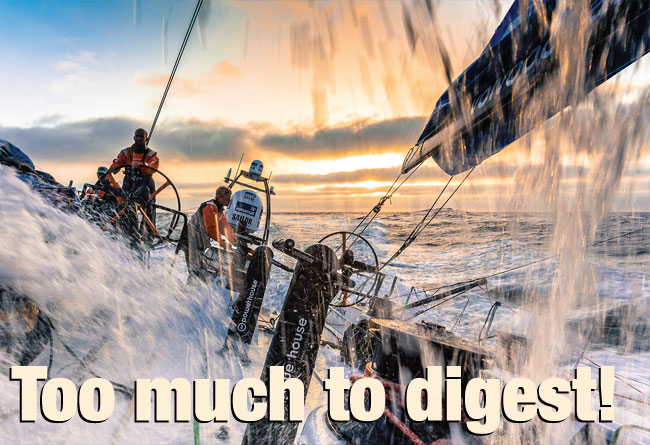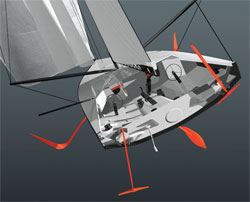

There’s been a lot going on at Volvo Towers in Alicante. JAMES BOYD catches up with round the world race supremo MARK TURNER
Wholescale change is afoot in the Volvo Ocean Race following Mark Turner’s appointment as CEO almost a year ago. The new measures, set to be implemented for the race after next are colossal, way, way more than merely adopting a new boat.
The latest initiatives for ‘Volvo Ocean Race – the next decade’ are intended to increase the value of the event to all its stakeholders: sailors purely focussed on winning, team owners, sponsors and partners, host cities, as well of course as the race’s owners, Volvo Group and the Volvo Car Group.
New offshore boat
Following debate about whether the replacement for the one-design VO65 would be monohull or multihull, the former was finally confirmed. After a lengthy tender process French naval architect Guillaume Verdier, one half of the partnership responsible for the last two Vendée Globe winners, won the contract to design the new boat. Yet to be named, this will be a foil-assisted, partially flying, canting-keel monohull. Likely to have more keel, more rig and more structure than an Imoca 60, the new boat’s design is aimed purely at the Volvo Ocean Race.
However… by coincidence Turner says the platform has ended up being much the same size as an Imoca: ‘Given how foiling technology is evolving, bigger is no longer necessarily better.’
So they decided to make it possible to transform the new boat into a Vendée Globe-compliant Imoca 60 if required. But Turner stresses this was decidedly a secondary feature – the brief was ‘the right boat for the Volvo Ocean Race’.
The new design will have a Volvo Ocean Race lifespan of six years. It will have five to seven crew, plus onboard reporter. Incentivising the recruitment of female and youth sailors will continue.
The boat will again be a one-design and Volvo have agreed to build eight boats (initially) with a delivery date between January and August 2019. The new fleet will be built by Persico Marine, who were involved in the construction of the initial VO65 fleet as well as the new eighth boat for AkzoNobel. The builders and tech n - icians within Volvo Ocean Race Boatyard in Lisbon will handle the fit-out.
While teams were initially expected to buy the VO65s, this time boats will be available solely on lease. This will eliminate the major capital entry cost for teams and give the event more control of its fleet. Sponsors involved in the present race will be given the first option to acquire boats when the NoR is published this October.
While a foiling monohull was chosen as the offshore raceboat this time, Turner says that a multihull, possibly a fully foiling one, could be chosen for the race in 2025. This decision will be made three to four years from now.
New inshore boat
For the edition after next the ‘ocean race’ monohull is to be supplemented by a 32-50ft one-design flying catamaran for the in-port races. Having a different boat for the in-ports is a deliberate choice by the organisers to broaden the challenge of their event: crews will now have to prove themselves in both offshore monohull and inshore flying multihull disciplines.
As Turner says: ‘By testing the sailors across two disciplines we have upped the game in a big way sporting-wise; now the winner can reasonably lay claim to being the best all-round sailing team full stop.
‘It is quite an exciting move forwards. But it is still called the Volvo Ocean Race and racing in the Southern Ocean remains at the core of its DNA – you are never just going to win it on the in-port races.’ Current in-port races in VO65s count only as a tiebreaker. The value of the in-port races will now be tweaked upwards.
The design and build of this new foiling catamaran are already out to tender. Again the aim is to build eight. Available on lease.
Which way?
It is yet to be confirmed whether the next race will be in 2019 or 2020; having gone down from a four to a three-year cycle prior to the 2008-9 race organisers are currently considering reducing this further to a two-year cycle.
In terms of courses, anything is possible, albeit with the aim of pulling off what no organising team have achieved to date: a rolling race programme, rather than a cycle culminating in a single round-theworld race every three or four years.
A programme of different routes would offer team sponsors a greater return on their investment. Teams could then set themselves up on a more permanent Extreme Sailing Series or Imoca-type basis, campaigning year in year out sometimes with diff erent backers, sometimes with different skippers, rather than this event’s more typical ‘one race in-and-out’ approach.
‘What’s important from both commercial and sporting perspectives is that there is more continuity and more action – and that there is a return on investment every budget year of a Volvo Ocean Race campaign,’ says Turner.
Contractually two more editions of the race will start from Alicante but future races could set off from outside Europe and routes could change drastically. The organisers have stated their commitment to visiting North America, South America, Australasia, Greater China and at least five major European markets at least once every two editions. For example, while this year’s race will visit 12 ports over eight months, future races could be shorter with fewer stops. This could reduce race duration, but more than 12 ports in the stated markets could be visited over two races.
Also on the table is a non-stop leg around Antarctica, and even a full nonstop lap around the world – the first time a non-stop crewed monohull race around the world would ever have been held.
Host cities will be able to choose from a range of stopover formats – from a 24-48 hour pitstop to shorter stopovers of five days to the full two weekend stopovers. Other options include hosting the mandatory Leg Zero qualifier as well as offering a home for team bases and Volvo Ocean Race Academies (see below).
Into the mix also goes a celebration of the race’s 50th anniversary in 2023. This may take the form of a special race on the original Portsmouth-Cape Town-Sydney- Rio-Portsmouth course and/or include a Legends race for past competitors and their yachts. The organisers are also aiming to lock in stopover ports for longer. Bidding is now underway for the next three editions.
Leg up
One of the most welcome developments is the creation of a ‘pathway’ into offshore yacht racing and ultimately the Volvo Ocean Race itself.
Traditionally many national authorities have a pathway into the Olympics – usually tied to funding. However, outside France such pathways in long-distance sailing remain rarer than a ferro-cement TP52… Even in France the thread Mini- Figaro-Class40-Imoca-Ultime focuses on shorthanded racing.
To address this Volvo, encompassing their round-the-world race, have entered into a new four-year partnership with World Sailing. The intention is for Volvo Ocean Race Academies to be set up as part of host venue agreements.
‘To move on from a dinghy class to an offshore shorthanded class, so you become a good, widely skilled sailor, your next step is logically the Volvo Ocean Race.
‘That is now part of the plan at World Sailing and we want to be on the inside of that,’ says Turner.

These academies could one day potentially become linked with the Olympics if offshore racing is adopted as an Olympic discipline; the formal proposal (issue 446) from World Sailing is currently being contemplated by the International Olympic Committee. Subject to getting the IOC nod, offshore racing could be showcased as early as Tokyo 2020 with the first offshore Olympic medals being awarded in 2024.
Historically Volvo have had a very longrunning association with youth sailing. From 1999 to 2010 it was title sponsor of World Sailing’s Youth Sailing World Championships, a traditional proving ground for future Olympic champions.
Outside the bubble
As if this were not enough, the Volvo Ocean Race is also introducing its Global Team Challenge as part of its new Leadership Development and Team Performance Programme – a corporate ocean race, shadowing the main event for part of its route using the present Volvo Ocean 65 fleet, with crews comprising three professional sailors and eight amateurs.
Being onboard a racing yacht with the objective of winning a race while working as a team in a hostile environment, maintaining morale and inspiring personal performance… these aspects of ocean racing are the reason offshore skippers are often invited to share management insights.
With this part of the programme the Volvo Ocean Race intends to formalise these lessons for the corporate world via on-land and on-water activities. This will be open to amateur sailors, including those with no previous sailing experience, who can compete in the whole event or individual legs.
Last but not least, the ‘new’ race is taking big steps to improve its green credentials, entering partnerships with the United Nations Environment Programme, chemical giant AkzoNobel and the Schmidt family’s 11th Hour Racing.
Also central to this is signing up to the UN Environment’s #CleanSeas Campaign, and their current major initiative: Turn the Tide on Plastic.
Working alongside Volvo Penta one of the long term aims of the race is to reduce and ultimately eliminate fossil fuel use on its boats, without compromising safety (for example the ability to motor if a boat is dismasted or in the event of a man overboard) or the ability to power satellite communications. A first step this year sees all the current VO65s now fitted with hydrogenerators.
Conclusion
Taking into account all of the above, the new ‘offer’ from the Volvo Ocean Race is colossal. And yet, largely thanks to boats being available on lease, Turner says he expects campaign budgets to remain much the same as today – around 12 million euros spread over two years.
‘It is pretty rare as a race,’ he concludes. ‘I don’t know any other big event where you get all of your satellite time, your team base shipped round and built for you, your RIB provided, fuelled and ready to go, medical services, weather package, equipment, all cameras and media stuff, your onboard reporter – all in the package…’
To return to where we began… Much like an Imoca 60 but stiffer, more powerful, more aggressive use of foils and so significantly faster. The Volvo is and always has been fundamentally a sailboat race and if the boats perform as promised, well, as is the case with any grand prix project, it’s the boats that will sell it.
Click here for more information on the Volvo Ocean Race »
We invite you to read on and find out for yourself why Seahorse is the most highly-rated source in the world for anyone who is serious about their racing.
To read on simply SIGN up NOW
Take advantage of our very best subscription offer or order a single copy of this issue of Seahorse.
Online at:
www.seahorse.co.uk/shop and use the code TECH20
Or for iPad simply download the Seahorse App at the iTunes store


